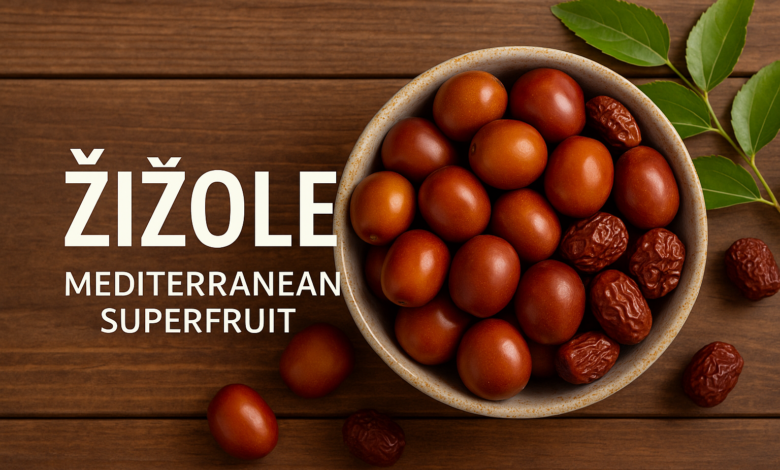Žižole: The Mediterranean Treasure of Taste, Tradition, and Well-Being

What Are Žižole? Names, Taste & Forms
- Botanical name: Ziziphus jujuba
- Also called: žižole / žižola / zizole (regional), jujube, Chinese date, giuggiole (Italy)
- Flavor & texture: fresh fruit is crisp and lightly sweet (apple-like); dried fruit is chewy with caramel tones (date-like)
- Kitchen uses: snacks, teas, compotes, syrups, jams, salads, pilafs, baked goods, and even infused spirits
Origins & the Mediterranean Connection
Native to parts of Asia, žižole traveled along historic trade routes and thrived in climates with hot summers and mild winters. Around the Mediterranean—particularly along the Adriatic coast and in northern Italian regions—the trees became part of home gardens and village markets. Italian speakers even coined a cheerful idiom, andare in brodo di giuggiole, to describe being overjoyed by something delicious.
Nutrition at a Glance (per 100 g fresh, approximate)
Values vary by variety and ripeness; treat these as general reference ranges.
| Nutrient | Approx. Amount |
|---|---|
| Calories | ~70–80 kcal |
| Carbohydrates | ~18–22 g |
| Fiber | ~2–4 g |
| Protein | ~1 g |
| Fat | ~0–0.5 g |
| Vitamin C | ~50–70 mg |
| Potassium | ~200–300 mg |
| Notable compounds | flavonoids, polysaccharides, saponins |
Benefits: What the Research Suggests
General information only; not medical advice.
- Immune support: Vitamin C contributes to normal immune function.
- Calming & sleep support: Traditional teas are sipped in the evening; modern studies explore gentle, sedative-like properties of certain compounds.
- Digestive comfort: Dietary fiber supports regularity; compotes and teas are classic soothing preparations.
- Skin & oxidative stress: Antioxidant compounds help neutralize free radicals.
- Everyday energy: Naturally sweet and portable, žižole make a satisfying snack alongside nuts and yogurt.
How to Eat Žižole (Fresh, Dried & In the Kitchen)
Fresh Snack Ideas
- Slice into salads with arugula, citrus, feta, and toasted almonds.
- Toss into grain bowls (farro, bulgur) with herbs and olive oil.
- Pair with cheeses on a seasonal mezze board.
Dried Žižole
- Steep in tea blends; simmer into compote with citrus peel.
- Fold into porridge, muffins, or energy bars.
- Add to pilafs with pistachios and chopped herbs.
Two Simple Recipes
1) Soothing Žižole Tea (10 minutes)
- 6–8 dried žižole (pitted)
- 2 cups water
- Optional: thin slice fresh ginger or strip of lemon peel
- Rinse the dried žižole.
- Simmer with water (and ginger/lemon peel if using) for 8–10 minutes.
- Strain and sip warm; lightly sweeten if desired.
2) Giuggiole-Style Syrup (for drizzle & drinks)
- 250 g fresh or dried žižole (pitted and halved)
- 500 ml water
- 250 g sugar or honey (to taste)
- Optional: 1 strip orange peel, 1 clove, tiny pinch salt
- Combine žižole, water, and aromatics; simmer 20–25 minutes.
- Strain; return the liquid to the pot.
- Add sweetener and simmer 10–12 minutes to a light syrup.
- Cool. Drizzle over yogurt, pancakes, or use in spritzes and mocktails.
Buying, Storing & Prep Tips
- Choosing: Look for firm, smooth fruit with even color.
- Season: Late summer to early autumn for fresh; dried are available year-round.
- Storage: Fresh fruit keeps in the refrigerator for 1–2 weeks; dried fruit stores for months in an airtight jar away from heat and light.
- Prep: Rinse, halve, and remove the pit before cooking or drying.
Growing Žižole at Home
- Climate: Hot summers and mild winters; many cultivars are drought tolerant once established.
- Sun & soil: Full sun; well-drained soil (tolerates sandy or poorer soils).
- Watering: Moderate—avoid waterlogged roots.
- Pollination: Several cultivars are self-fertile; cross-pollination can boost yields.
- Harvest: Usually September–October, when skins flush red-brown and fruit tastes sweet.
- Containers: Dwarf types can thrive in large pots with regular pruning and feeding.
Culture Notes: Giuggiole & Seasonal Traditions
From backyard trees in Dalmatia to market stalls in Veneto, žižole is both ingredient and symbol. Families snack on the fresh fruit, simmer syrups for winter treats, and brew evening teas. In Italian, the phrase andare in brodo di giuggiole—literally “to go in a broth of giuggiole”—captures the delighted, almost childlike joy the fruit inspires.
FAQs
Is žižole the same as jujube?
Yes. Žižole is a regional name for jujube (Ziziphus jujuba), also known as giuggiole in Italian.
How do žižole taste?
Fresh žižole are crisp and mildly sweet; dried žižole are chewy and date-like with caramel notes.
Are žižole healthy?
They are typically rich in vitamin C, contain fiber, and offer antioxidant compounds. Enjoy them as part of a balanced diet.
Can I eat the skin?
Yes—the thin skin is edible. Remove the pit before cooking or drying.
How do I use žižole in cooking?
Snack fresh, steep into tea, simmer into compote, bake into cakes, fold into pilafs, or make syrup for desserts and drinks.
Will a žižole tree grow in my garden?
If you have full sun, well-drained soil, and warm summers, it’s likely. Many cultivars are forgiving once established.
Conclusion
Žižole brings together flavor, heritage, and practical nourishment in one small fruit. Crisp when fresh, luscious when dried, it adapts effortlessly—from salads and teas to syrups and sweets. Rooted in Mediterranean memories yet perfectly suited to modern kitchens, žižole is a simple way to add brightness to your day and depth to your cooking. If you’re new to jujube, start with a pot of soothing žižole tea or a jar of giuggiole-style syrup—then let the season guide your next creation.





